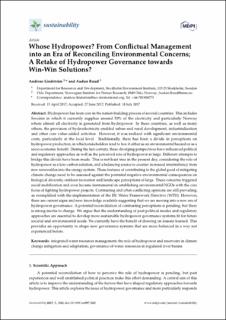Whose Hydropower? From Conflictual Management into an Era of Reconciling Environmental Concerns; A Retake of Hydropower Governance towards Win-Win Solutions?
Peer reviewed, Journal article
Published version

Åpne
Permanent lenke
https://hdl.handle.net/11250/3076625Utgivelsesdato
2017Metadata
Vis full innførselSamlinger
- Publikasjoner fra CRIStin - NINA [2364]
- Scientific publications [1392]
Sammendrag
Hydropower has been core in the nation-building process of several countries. This includes Sweden in which it currently supplies around 50% of the electricity and particularly Norway where almost all electricity is generated from hydropower. In these countries, as well as many others, the provision of hydroelectricity enabled urban and rural development, industrialization and other core value-added activities. However, it was realized with significant environmental costs, particularly at the local level. Traditionally, there has been a divide in perceptions on hydropower production, in which stakeholders tend to box it either as an environmental hazard or as a socio-economic benefit. During the last century, these diverging perspectives have influenced political and regulatory approaches as well as the perceived role of hydropower at large. Different attempts to bridge this divide have been made. This is not least true in the present day, considering the role of hydropower as a low-carbon solution, and a balancing source to counter increased intermittency from new renewables into the energy system. These features of contributing to the global good of mitigating climate change need to be assessed against the potential negative environmental consequences on biological diversity, outdoor recreation and landscape perceptions at large. These concerns triggered social mobilization and even became instrumental in establishing environmental NGOs with the core focus of fighting hydropower projects. Contrasting and often conflicting opinions are still prevailing, as exemplified with the implementation of the EU Water Framework Directive (WFD). However, there are current signs and new knowledge available suggesting that we are moving into a new era of hydropower governance. A potential reconciliation of contrasting perceptions is pending, but there is strong inertia to change. We argue that the understanding of past political modes and regulatory approaches are essential to develop more sustainable hydropower governance systems fit for future societal and environmental needs. We currently have the benefit of drawing on lessons learned. This provides an opportunity to shape new governance systems that are more balanced in a way not experienced before. integrated water resources management; the role of hydropower and reservoirs in climate change mitigation and adaptation; governance of water resources in regulated river basins Whose Hydropower? From Conflictual Management into an Era of Reconciling Environmental Concerns; A Retake of Hydropower Governance towards Win-Win Solutions?
